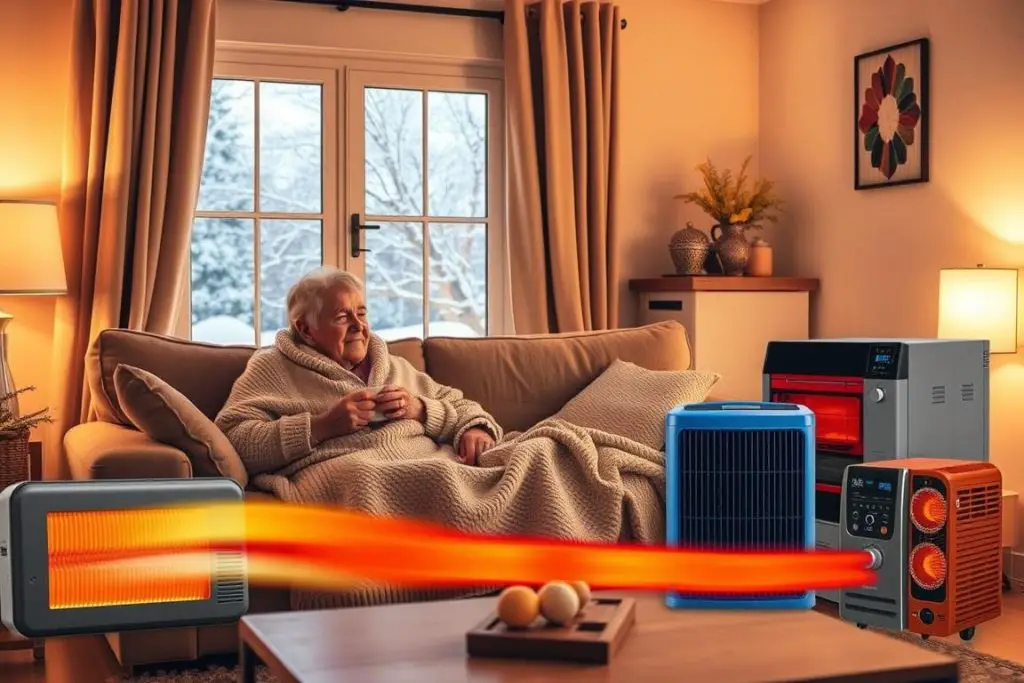Did you know about 20% of U.S. homes were behind on their energy bills last year? With cooling costs jumping from $476 in 2014 to $719 in 2024, it’s clear why. Paying for heating in the winter and cooling in the summer stretches many budgets thin.
But there’s good news: the Low-Income Home Energy Assistance Program (LIHEAP) can help. This program is designed for low-income families. It provides crucial support for heating and cooling bills. LIHEAP looks at things like how much money your family makes, your home type, how many people live there, and what you use to heat your home.
While LIHEAP might not cover every energy cost, it’s a key source of aid for those struggling with their bills.
Key Takeaways
- Approximately 20% of U.S. households were late on a home energy bill in the past year.
- Cooling costs have increased from $476 in 2014 to $719 in 2024.
- LIHEAP provides critical energy assistance to low-income households, particularly for heating and cooling.
- The program considers factors such as household income, residence type, and the number of residents.
- LIHEAP focuses on the primary heating and cooling sources to offer tailored support.
Understanding LIHEAP: A Lifeline for Low-Income Households
As energy costs go up, many families struggle to pay their utility bills. The energy assistance program called the Low-Income Home Energy Assistance Program (LIHEAP) is a key support for these families. It is an affordable energy assistance plan that helps protect vulnerable people from the cold and heat.
About 16% or 21.2 million U.S. households are behind on their energy bills. In FY23 alone, LIHEAP helped 7.1 million households. The elderly, disabled, and children face big risks without heating or cooling. A shocking 14 million U.S. homes don’t have air conditioning. This shows how critical emergency energy assistance is today.
In recent findings, Louisiana had 31.4%, West Virginia 28.5%, and Massachusetts 27.8% of adults who couldn’t fully pay their energy bills last year. The need for more federal funding is clear. NEADA suggests adding $2 billion to prevent 1.4 million families from losing aid. Without enough LIHEAP funds, states like New York could serve 414,186 fewer households. Michigan, Pennsylvania, and New Jersey would also see big impacts.
LIHEAP does more than give money. It also supports making homes more energy-efficient. With climate change causing more extremes, this program is increasingly important. Yet, it faces a big challenge. Under 3% of those eligible got cooling help recently. This is a problem, especially for the elderly and those with low incomes.
To fix these issues, we need to come together. Improving how people take part in LIHEAP plans is key. So is making it easier for people to sign up. Everyone — from policymakers to community members — must work together. This way, we can keep offering affordable energy assistance to those in need.
| State | Potential Reduction in Households Served if LIHEAP Funding is Cut |
|---|---|
| New York | 414,186 |
| Michigan | 94,446 |
| Pennsylvania | 54,005 |
| New Jersey | 52,025 |
| California | 47,131 |
| Virginia | 44,201 |
| Kentucky | 42,615 |
| Wisconsin | 37,501 |
| Georgia | 36,487 |
| Connecticut | 34,327 |
Eligibility Requirements for LIHEAP
Understanding the key criteria for LIHEAP eligibility can help you determine if you qualify for energy bill payment help. Primarily, LIHEAP assistance depends on income guidelines, and the applicant’s responsibility for paying heating costs.
Income Guidelines
To be eligible for LIHEAP, your household’s income must not exceed the greater of 150% of the federal poverty guideline (FPG) or 60% of the state median income (SMI) level. States set their income eligibility standards within these maximums and minimums.
Notably, 18 states use the 150% maximum income eligibility, while 11 states have ranges from 110% to 150%, and 14 states along with the District of Columbia opt for 60% of the SMI.
| Household Size | Maximum Annual Income (150% FPG) | Maximum Annual Income (60% SMI) |
|---|---|---|
| 1 | $20,385 | $25,760 |
| 2 | $27,465 | $34,840 |
| 3 | $34,545 | $43,920 |

In some states, an assets test is also used in addition to the income requirements. These allowable assets range from $2,000 to $20,000 per household.
For new applicants, maintaining documentation and meeting state-defined qualification standards is crucial for securing energy assistance for seniors.
It’s important to note that each state varies income guidelines by component or household type. These components may include weatherization or crisis scenarios, particularly for households with vulnerable members.
Utility Payment Responsibility
The applicant must be responsible for paying heating costs. This means that the adult living at the property must directly pay for heating expenses.
Authentic payment histories toward primary heating energy are necessary to demonstrate this responsibility. This dual consideration of income qualifications and utility payment duty is pivotal in determining your eligibility for LIHEAP energy bill payment help.
“Qualifying for the Low Income Home Energy Assistance Program can significantly reduce the financial burden of energy bills, making homes safer and more energy-efficient.”
How to Apply for LIHEAP Energy Assistance
The Low Income Home Energy Assistance Program (LIHEAP) helps families with heating and cooling bills. Knowing when and how to apply could help you get the most help you can. It’s all about the right timing and following steps carefully.

Application Period
The time to apply for energy assistance through LIHEAP is set each year. For example, Kansas might open applications from January to March. In Pennsylvania, the period was from November 1, 2023, to April 5, 2024. Make sure to apply during these dates for the best chance at help.
Application Process
Applying for LIHEAP has a few important steps:
- First, gather all needed documents. Collect things like income proof, bill copies, social security cards, rental agreements, and other benefit proofs like TANF or SNAP.
- Next, submit your application. You can do this online through certain websites or at drop-off locations for paper forms. Broward County, Florida, suggests using their online portal for applications.
- Your application will be looked over. This can take up to 30 business days. If you’re in a crisis, they’ll look at your application sooner.
- Last, if you’re approved, you’ll get money to help pay your bills. The amount varies from $300 to $1,000, depending on your family size and income. Emergency help, like fixing your heater, might also be available.
Places like Catholic Charities give extra help with the how to apply for energy assistance process. Special attention is given to seniors and people with disabilities. They can apply early, starting October 1, 2024, ensuring they get help quickly when needed.
Conclusion
Dealing with household expenses is tough, especially when energy bills use up a lot of your budget. The Low-Income Home Energy Assistance Program (LIHEAP) is key. It gives needed help to many American families, making their lives easier. By helping with heating, cooling, and making homes more energy-efficient, LIHEAP keeps low-income families healthy and safe.
To benefit the most from this crucial assistance, you must act early. Check if you qualify by looking at income, household size, and where you live. It’s important to apply within the right time frame, though this can change depending on your state. Families with elderly, disabled, or young members often get priority. This shows LIHEAP’s commitment to helping those in need first.
Getting help from LIHEAP can greatly reduce how much you worry about bills. But it’s also wise to look for more help and stay updated on any changes to the program. By acting quickly and keeping informed, you can better handle your energy costs. This means you can enjoy a more comfortable home all year.
FAQ
What is LIHEAP and how does it help with energy bills?
LIHEAP stands for the Low-Income Home Energy Assistance Program. It is funded by the federal government. The program helps low-income families pay for heating and cooling. It makes sure people do not have to choose between food and a comfortable home.
Who is eligible for LIHEAP?
To be eligible for LIHEAP, your income must be below 130% of the federal poverty level. You must also pay for heating in your home directly. Plus, you should have a record of your payments. Each state has its own income rules.
When can I apply for LIHEAP in Kansas?
In Kansas, the LIHEAP application period starts on January 16 and ends in late March. It’s important to apply within this time to get help.
How do I apply for LIHEAP energy assistance?
You can apply for LIHEAP online or at certain drop-off spots. You’ll find needed contact details like email and phone numbers easily. Organizations like Catholic Charities can also guide you through the process.
Can LIHEAP assist with both heating and cooling costs?
Yes, LIHEAP helps with costs for both heating and cooling your home. It might also help improve your home to use less energy. This depends on your state’s rules, though.
What if I need emergency energy assistance?
If it’s an emergency, some LIHEAP programs offer fast help. Contact your local LIHEAP office or community groups right away. They will tell you what to do next.
Is there additional help for seniors needing energy assistance?
Yes, LIHEAP really focuses on helping seniors since they have fixed incomes. The program helps keep their homes warm or cool. This is to make sure they stay healthy and safe.




